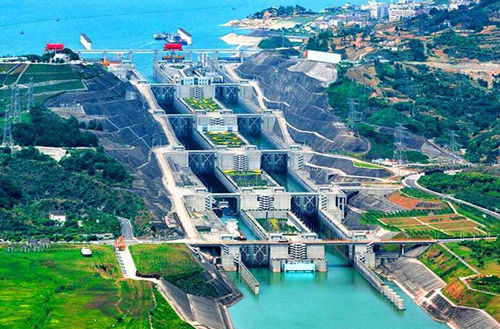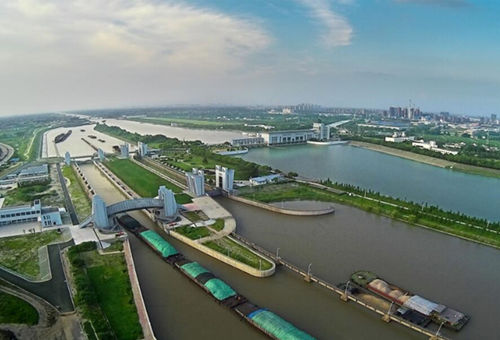Canal meijinghua shiplock
Whenever people mention the Beijing-Hangzhou Grand Canal, they can’t help but call it "beautiful". In fact, the beautiful Beijing-Hangzhou Grand Canal, apart from its antiquity and civilization, has a unique flavor for its shiplocks. Especially in the northern Jiangsu Canal, it can be said that there are ten locks and ten landscapes. They are like ten bright pearls embedded in the 404-kilometer Grand Canal, and the ancient Grand Canal is decorated with beautiful scenery, which is particularly enchanting. In the 1980s, as a member of maintaining social order in the northern Jiangsu section of the Beijing-Hangzhou Grand Canal, I fought, patrolled, lived on the Grand Canal, and had zero contact with ten shiplocks along the way, and fully felt their unique scenery, mood and taste.

In the spring of 1980, after I retired from the army, I was assigned to the Shao Bo Police Station of Jiangsu Canal Public Security Bureau (No.8 Gangkou Road, Huaiyin City). The police station is located on the bank of Shao Bo Lake in the lower reaches of Hongze Lake with beautiful scenery. Together with Shaobo Ship Lock, it hides in a thick cedar and tall unlined upper garment forest. If it weren’t for the loud "cry" of ships coming and going, it would be a paradise. The police station and the lock management office are located in a small courtyard next to the lock, surrounded by a circle of antique glazed tile walls, fan-shaped wall holes and a small round door, which wraps three rows of bungalows (two rows are the rooms for the lock management office and one row is the place for the police station). Since then, I have camped in the police station and stayed with Shaobo Ship Lock day and night.
Shaobo Ship Lock was first built in 1934. Although the old lock has been scrapped, there is still an old lock wall standing along the river on the east bank of the canal. On this site, there is the autograph of "Jiang Zhongzheng", with three Chinese characters one meter square, embedded in the canal bank with cast iron, which fully shows how much attention the Kuomintang government paid to the development of canal transportation and water conservancy. Later, the ship lock was built in 1962. The lock chamber made of reinforced concrete and four watchtowers, like "Four donkey kong", stood on the Grand Canal. Because I was single, I had to take Zhajia as my home and guard the Subei Canal with the "Four donkey kong".
The scenery of the ship lock in those days was unique and charming. In the early morning, I can stroll by the Shao Bo Lake near the gate and feel the beautiful scenery of the lake overlooking the lake, with vast smoke waves and little fish sails; Walking up and down the lock, smelling the passing ships burning small stoves and making breakfast, the smoke and rice fragrance floating out are refreshing and appetizing. In addition to its architectural beauty, scenic beauty and greening beauty, the ship lock also has the unique beauty in the lock room, which is constantly presented to me.

The first is the beauty of "fishing for money".
Unlike now, toll collectors on the gates are all in remote dispatching stations or central command rooms, using computers to complete the tasks of registering and charging passing ships. At that time, the toll collectors on the gates were all beautiful women with special skills. Each of them carried a ballot box, held a wallet and put a long rope (cotton) on their wrists. After calculating the cost of crossing the gates according to the number and tonnage of ships crossing the gates, they tore off the quota invoice and clamped it with iron clips. With the waving of their arms, the long rope flew out of a dazzling arc and landed on the docked bow accurately. The boatmen are always happy to accept invoices, change into banknotes, and then throw them at the toll collectors with iron clips. The beauty toll collectors pulled hard by inertia, and the long rope crossed a beautiful arc in the air and fell into their arms.
The second is the beauty of releasing water.
The water level difference between the upstream and downstream of a ship lock is usually several meters or more than ten meters. When the ship enters and exits, it must pass through the gate entry, gate closing and water release from downstream to upstream, and then open the gate and leave the gate after the water level is equal to that of the upstream. The release of water from the lock chamber is a scene of the lock. When the lock workers turn on the hoist (the button was manually operated in those days, but now it is controlled by the computer), the river in the upper reaches is like a runaway wild horse, rushing out from the lock wall, and the big waves, the noise and the water mist constitute a symphony of the lock. Under the refraction of sunlight, water mist can sometimes form a seven-color rainbow over the ship lock, which is beautiful and dreamlike. And I often worry about the safety of the ship in the lock room under this beautiful scenery. In fact, there is no need to worry. Before the fleet entered the lock, the broadcast on the watchtower reminded: "Attention, comrades of the crew, the lock is about to release water. Please put on your life jacket, fasten the cable and take the bamboo pick. Pay attention to safety. " The beauty announcer of the ship lock, the gentle and drizzling reminder, made the passing crew full of enjoyment in their vigilance.
The third is the beauty of rock climbing.
In those days, you had to climb the approach pier of the ship lock and hand in the navigation book to the gate workers before registering for crossing the gate. After entering the lock, you have to climb the lock surface along the lock wall and take away the navigation book. When the ship lock is in low water, it is thirty or fifty meters away from the lock surface. When the crew members walk on the Grand Canal all the year round, they will inevitably climb up and down at the lock. In the long run, they will all practice a unique skill of "rock climbing". Whenever the lock releases water, you can always see many crew members climbing. The simple costume, the vigorous figure, the bronze skin and the protruding muscles, like geckos, walk up and down the lock, vividly showing a "rock climbing map" of the lock.
The fourth is the beauty of lookout.
There are four watchtowers at the four corners of the lock. The one in the southeast is the command tower, also called the dispatching tower. Climbing to the top of the tower, the surrounding scenery is unobstructed. Looking to the west is the rippling Shaobo Lake, and the derricks of Subei Oilfield are dotted in the distance. Looking eastward, the ancient town of Shao Bo is near by the river, and the big docks, Dawang Temple and Shiban Street where Emperor Yangdi and Qianlong set foot in ancient times can be vividly seen. Looking to the south, the Grand Canal suddenly widened, connecting with Shaobo Lake, and flowing to the ancient city of Yangzhou against the backdrop of the slate of the east bank canal levee. Looking to the north, the Grand Canal floats from the north like a silver ribbon, and flows to the ancient town of Shao Bo in the guise of green trees on the west bank canal levee.
The above four beauties can be said to be the common beauty of Subei Canal and ten shiplocks. Of course, apart from the similarities, there are also many characteristics that show the beauty of individuality. As for the difference of beautiful scenery, it should be that ten shiplocks are different. For example, Shiqiao Ship Lock in Yangzhou is famous for its royal garden style. Its rockery pavilion, small bridges and flowing water echo the ship lock architecture, and its pines, cypresses and winding paths add color to Shiqiao Ship Lock. In the last century, she was included in Yangzhou, an important place to receive foreign guests. I also served as the security guard for delegations from Romania, Albania and North Korea under the arrangement of the police station.
Our Huai ‘an Ship Lock is famous for its water conservancy hub, and the water interchange upstream of the ship lock is the only one in China. Huai ‘an Fanshui Station is an important project of North-to-South Water Transfer Project, which has made great contributions to continuously transporting Yangtze River water to Beijing, Tianjin, Hebei and Shandong. The Siyang Shiplock in Suqian is famous for being located in an orchard. The fragrance of fruits, cherries in spring, peaches in summer and apples in autumn make the past crew linger. The Zaohe Shiplock in Suqian is surrounded by luoma lake on the left and Zaohe Ancient Town on the right. The history that Qianlong stayed in Zaohe Palace for many times added a heavy stroke to the classical beauty of Zaohe Shiplock. The Jietai Shiplock in Xuzhou is full of flowers and trees. Entering a ship lock is like stepping into a world of flowers, a green ocean.
This is the canal lock that I remembered more than 30 years ago. Nowadays, many of the ten shiplocks have built three-line shiplocks and double-line shiplocks. Our two shiplocks in Huai ‘an are all three-line shiplocks, and they are the first shiplocks to realize modern management, ranking first in scientific management in China, especially in remote control, which has reached the world-class level. As the heart of ship lock command — — The Subei Navigation Management Office of Jiangsu Provincial Communications Department of Beijing-Hangzhou Canal is located on Yan ‘an East Road in the urban area, which plays an important role in the urban and economic development of Huai ‘an. Although Shidao Shiplock is not what it used to be, its aura is still there, and its scenery is more beautiful.
(Source/Huai’ an Literature and History Network Author/Shen Weihua)